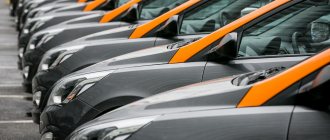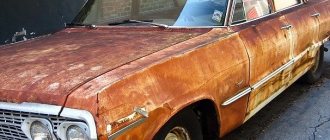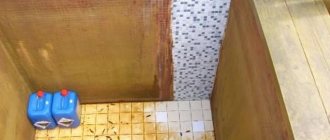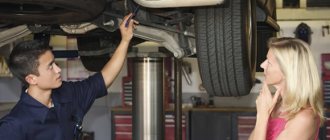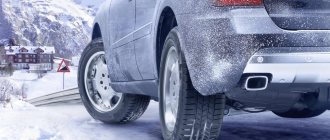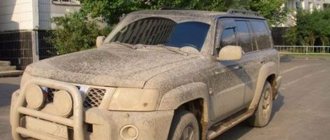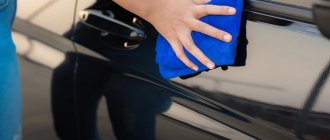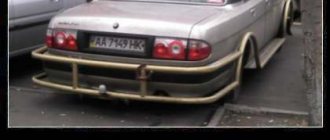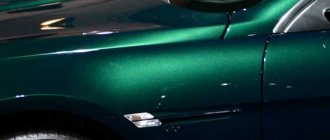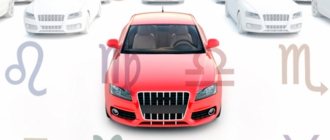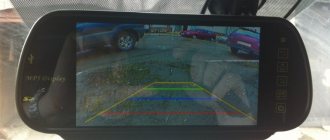The main enemy of a car body is corrosion; rust primarily appears in areas of the body with unprotected metal, not covered with paint, primer, or special anti-corrosion agents. How to treat the underbody of a car so that it does not rust is a hot topic for many motorists, because not all compounds provide reliable protection, and it is also necessary to correctly apply the protective layer, following the technology.
Properly performed processing in compliance with all rules guarantees a long service life of the body and prevents rusting of the car. And you must not forget to keep the car in good condition, because over time, defects may appear on the treated surface, the anti-corrosion agent (anti-gravel) may peel off or fly off.
Compositions for treating the underbody of a car
How best to treat the underbody of a car is a pressing question; choosing the “right” composition from the entire range of mastics, Movils, rust converters, anti-gravel coatings is not easy, the industry offers many brands and brands of various auto chemicals. Users and automotive experts have compiled many ratings published on the Internet; among anti-corrosion agents, the following chemical brands are considered the best:
Anticorrosive compounds are produced for both hidden and external surfaces, and the requirements for these compounds are different. The main properties that an anti-corrosion drug should have are:
- good adhesion (reliable adhesion to the body surface);
- the ability to reliably protect metal;
- low toxicity;
- tightness;
- fire resistance;
- elasticity (the coating should not crack or peel);
- heat resistance (the properties of the material should not change and depend on temperature).
Treatment of the underbody is carried out in several stages, and several chemical agents are almost always used. Each of the anticorrosion agents can perform several functions at once, not only prevent the appearance of rust and fight corrosion, but also serve as noise and vibration insulation, and act as body protection from impacts (pebbles, gravel, glass fragments flying from the road).
When is underbody treatment necessary?
Often car owners think about protecting the car body only when it begins to rust. But a rusty bottom is already quite a big problem; to restore it, you often have to use welding, apply patches, and carry out quite labor-intensive work. The machine should not be allowed to rust; it is necessary to carry out anti-corrosion treatment:
- once every 3-4 years (or more often, the frequency depends on how well the body of a particular car model resists corrosion);
- immediately after purchasing a used car;
- in case of collision with an obstacle with the bottom and damage to the anti-corrosion layer (its tearing off).
It is no secret that many new cars do not receive high-quality treatment, so immediately after purchase it is recommended to look under the car and assess the condition of the anti-gravel coating. With a thin protective layer of anti-gravel, additional treatment is required; the anti-corrosion composition should be applied before the car begins to be used. If the car has not yet been driven on the roads, it will take less time to prepare; you do not need to thoroughly wash the bottom and wheel arches.
Car underbody paint
While it's summer, you can work on the car!) For a long time I've wanted to properly wash the bottom and do an anti-corrosion treatment, because... From the factory there was no anti-corrosion agent there, except for the rear arches. The bottom of the car is galvanized and simply painted with a layer of paint, and a rather thick layer! But due to time and our reagents on the roads, rust began to appear in some places, which does not suit me at all! We will correct the situation!
In mid-July, I put the car on birch stumps (very comfortable and durable, a good alternative to conventional stands!)))) and began to wash the bottom... this job seemed to me quite simple and quick... how wrong I was))) I first tried to wash the rear part a brush for washing a car... but due to the difficult terrain, it was not possible to crawl everywhere... and the puddle under the car was VERY large)))) So, I had to arm myself with a bunch of rags, small brushes and wash the entire bottom by hand! The most time-consuming part is the bottom itself, it is very inconvenient to wash due to the exhaust system constantly getting in the way))) The whole wash took a total of 6-7 days))) After washing off the dirt, I began to unscrew the boot under the rear bumper. It is attached with 7 screws (3 to the rear bumper reinforcement, 2 to the bumper itself, 2 to the trunk floor). All the screws came out without any problems... all except one, which was very rusty and did not want to come off (the screw in the trunk floor) - I had to saw it off))) Then I pulled out all the plastic pistons/clips that secure the lower part of the bumper and the plastic sill trim.
After washing, the whole picture of the condition of the bottom became visible - in places there is surface rust, but nothing critical!
The factory anti-corrosion protection on the rear arches is in excellent condition! Even the paint on the frame remained intact - this is not factory paint, I applied it 2-3 years ago. The only badly damaged place was the lower part of the arch and the floor in the niche for the spare tire - the place is not very good, it is not protected by anything and all the dirt constantly flies there... there is not a trace left of the anti-corrosion agent, everything has been sandblasted down to the metal, in some places the paint has already begun to peel off...
But the rust is only superficial, the metal is strong... everything had to be cleaned and treated with Zinkar.
The rear bumper reinforcement is in its original paint in some places, but not in others anymore))) Although there is a plastic dust shield installed under the bumper, there is a gap next to the frame through which dirt and moisture flies there.
The left rear arch almost completely retained the factory anti-corrosion protection; the only place with surface rust was the side reinforcement of the rear bumper (which is also the lower part of the wing) - all the dirt from under the wheel also flies onto it.
Preparing the body for anti-gravel treatment
The entire process of applying anti-gravel consists of three main stages:
- surface preparation;
- soil covering;
- treatment with anti-corrosion compound.
The complexity of the preparation depends on the condition of the body itself: if there are pockets of corrosion, it is necessary to remove rust, if necessary, cut out pieces of rotten metal, install patches if holes appear in the bottom. But first of all, the surface to be treated must be thoroughly scraped, washed and dried, only then should body work be performed. When removing dirt, there is one caveat - dust and debris are quite difficult to remove in hard-to-reach places, for example, from hidden cavities; it is better to get rid of it using compressed air.
Before washing, dry cleaning of dirt is always carried out; it is convenient to clean the body with a wire brush, and in places of bends - with sandpaper.
When removing rust with sandpaper and cleaning the metal, it would be a good idea to give the surface some “dullness”; this is done so that the primer lays more firmly on the metal surface and adheres to the metal.
Before thoroughly cleaning the corrosive areas, the rust is treated with a special compound - a rust converter; this chemical can always be found in stores selling paint and varnish materials for cars. The converter is applied to the metal surface with a soft brush to make it easier to dip the brush; part of the liquid from the bottle is poured into a convenient wide container
After applying the composition, rust almost immediately begins to react with the chemical, the liquid begins to foam, and the rust is “eaten up.”
Rust converters - types and features
Rust converter is an effective chemical agent in the fight against corrosion; most often the main component of the composition is phosphoric acid. This chemical not only allows you to get rid of rust, but also protects the metal for a long time, creating a protective film. In Russia, the most widespread and popular brands of converters are:
Converters are not only liquid, but also paste-like, in the form of a gel; some products are applied by spraying; the bottles contain a spray bottle. As a rule, 15 minutes after processing the metal surface is enough for the rust to transform and be ready for further processing. After the converter has dried, the area to be treated must be cleaned with sandpaper or a metal brush, and then degreased.
Body primer treatment
After complete preparation, the protected areas of the underbody must be treated with a primer, in other words, primed (a primer is the same primer). It is more convenient to apply the primer with a spray bottle, you can also use a regular paint brush, but in the second case, the processing will take longer, and the primer material will not lie so evenly on the body surface. Another plus of a spray gun is that it is more convenient to cover metal with primer in hard-to-reach places; the spraying method guarantees an even layer over the entire bottom of the car.
It is necessary to treat all areas of the body with bare metal and areas etched with a rust converter with a primer, but if the primer gets on the protected parts of the bottom, it will not make it worse. The next stage is to coat the entire body surface from below with primer, but if the bottom has not suffered from corrosion, you can skip this stage, making do with good preparation (cleaning) and degreasing. After this, it will not be superfluous to treat the welding seams and recesses with sealant, and also seal the surface around the welded cups.
The primer and sealant must dry thoroughly, only then can you proceed to the next stage of processing - applying an anti-corrosion coating.
Application of anti-gravel
The anti-corrosion agent comes in various types; it can be a preparation like Movil, mastic or anti-gravel. The protective coating is applied to the body surface in three ways:
- spraying from a bottle (if the packaging bottle is equipped with a sprayer);
- using a spray gun (if you have this device and a compressor with compressed air);
- with a brush or roller, this method is usually used if the bottom is treated with mastic.
The use of a spray gun is the most effective method of treatment: the anti-gravel layer is applied evenly to the body, while high productivity is achieved and time costs are minimal. But not all car owners can carry out such treatment, as they do not have the necessary equipment.
The anti-gravel composition is also applied quite evenly from a spray can, but the productivity here is low, the processing takes longer. You can coat the bottom with a brush, but you need to be patient and get used to applying the anti-corrosion layer evenly. The body is covered with Movil or anti-gravel in two or three thin layers, after each treatment it is necessary to allow the composition to dry for 20-25 minutes.
Movil for anti-corrosion treatment of the bottom
There are many chemical preparations for anti-corrosion treatment of the underbody on the automotive market, and one can argue endlessly about which product is better. Movil is very popular in Russia; this anticorrosive agent was developed in laboratories in Moscow and Vilnius. It is believed that Movil is more suitable for treating hidden cavities, however, it is often used to cover the bottom; depending on the brand, the composition is quick-drying and may not dry for a very long time. There is no big difference between the product and the manufacturer; all companies produce anticorrosive agents with similar chemical properties.
Movil "Zinc" is most often sold in half-liter bottles, applied with a brush, treatment is carried out in two or three thin layers, after each application you must wait 20 minutes. The main advantages of this composition:
- very low price;
- high elasticity;
- Possibility of applying the product to a painted surface.
Disadvantages of Movil - strong odor, poor resistance to mechanical stress. The layers when applying anti-corrosion protection must really be very thin, otherwise everything may simply fall off.
Vulnerable spots of the body
The cause of the chemical oxidation reaction, most often, is poor-quality paintwork and mechanical damage to the outer protective layer. At the same time, seams, joints of body parts, exhaust system parts and transmission elements are most susceptible to corrosion. In addition, rust appears in poorly ventilated areas - under wheel arches and in various cavities. It should be borne in mind that temperature changes, strong vibration and high concentrations of gases in the atmosphere only accelerate the destruction of the metal. Sand, industrial salts, including calcium chloride contained in modern de-icing agents have a destructive effect on chrome-plated parts. Depending on the location of a particular element, its destruction may occur a little slower or, on the contrary, faster.
Anti-gravel compounds
Anti-gravel is often produced under foreign brands and comes in black, gray and white. The most well-known brands of this product for treating the lower part of the bottom:
- Tectyl Bodysafe;
- Tectyl Zinc Bodysafe;
- Dinitrol 479;
- Protex;
- Mercasol 3;
- Liqui Moly.
The anti-corrosion material Dinitrol 479 is often called “liquid fender liners” and is used to treat both wheel arches and the outside of the car’s underbody. Usually the product is sold in liter and 5-liter jars; Dinitrol is based on polymer rubber. The anticorrosive color is black, the manufacturer guarantees the reliability of the coating for seven years.
The protective layer of Dinitrol 479 tolerates high and low temperatures well, the maximum permissible temperature at the upper level is +85 degrees Celsius. To make the composition more fluid, it is recommended to warm up the anticorrosive agent before applying it. In addition to its protective functions, Dinitrol also improves sound insulation qualities and has good ductility. The disadvantages of this anti-gravel coating are that the price is not too low, the consistency is thick, and it must be diluted with white spirit.
The anti-corrosion composition Liqui Moly is a mixture of synthetic resins and bitumen, as it has good adhesion and can be applied to the surface to be treated in one thick layer (up to 1.5 mm). The product is sold in bottles of 0.2/ 0.5/ 1.0 l, complete drying of the anticorrosive agent takes from 12 to 24 hours.
Mastics for treating body underbody
To protect the car body, three main types of mastic are used:
- rubber bitumen;
- polymer-bitumen;
- epoxy.
Any mastic is characterized by a fairly low cost, is characterized by ease of use and high durability. Products under the Bikar and Allright trademarks are known on the Russian market; anti-corrosion material is applied with a brush or spray gun and has good adhesion.
It is better to dilute the bitumen-rubber mastic “Oilwright” with regular gasoline and apply it in warm or hot weather. Mastic on the bottom of the car holds better than anti-gravel sprayed from a can, does not crack and resists mechanical stress well. As a rule, treatment with this product is enough for 2-3 years of car operation, but the big disadvantage is that bitumen mastic stains everything possible, and it smells quite unpleasant.
How to paint the underbody of a car»>The main point that a vehicle owner has to think about is painting the underbody of the car, as well as choosing the most suitable material. It is necessary to select a coating that will be as resistant to moisture, sand and gravel as possible, and that can ideally fit on a surface that is heavily corroded. The underbody of a vehicle is a detail where aesthetic qualities fade into the background, and parameters such as durability and reliability are at the forefront.
Features of material selection
To effectively protect the underbody of a car, a large number of different materials are used, more than half of which are paints. Among the various primers with an anti-corrosion effect, the following compositions can be distinguished:
- Epoxy primer, which is able to set sufficiently high adhesion parameters, and also has durability indicators;
- Lead plumbate or special red lead, which provides optimal protection against moisture and various mechanical damages;
- Special liquid, cold zinc is used, which can replace factory galvanization;
- Liquid plastic, as well as special corrosion-resistant mastics. In terms of their level of protection, they are a little like soil, but with sufficiently strong vibration they can peel off;
- Anti-gravel compounds, which in their properties are a little similar to rubber. In addition, they effectively correct the special shock-absorbing properties inherent in metal;
- Special gun oil can provide optimal protection. It is recommended to use it only in certain areas, since it wears off with constant mechanical impact;
- Over relatively mild corrosion, you can use a special one.
The choice of one material or another directly depends on the characteristics and general condition of the underbody of the car.
How to prepare paint for painting the engine and valve cover with your own hands
To make your own paint, you need to mix several components, maintaining the proportions. For example, the composition of silver paint includes solvent, epoxy paint and varnish (drying oil), and aluminum powder.
Please note: Basic principles of painting a car fender
For proper preparation, the ratio of the latter with drying oil is 2 to 5. The solvent is added to the desired consistency. The finished composition can be used to treat areas on the engine where there is practically no heating.
On the remaining surface exposed to heat, it is better to apply heat-resistant compounds that can withstand up to 400°C. And to treat the exhaust manifold, you need a mixture that does not lose its properties even at 1100°C. For colder areas, you can choose a different composition, after consulting with a specialist.
Preliminary surface preparation
Complete removal of old or factory paint is not considered mandatory, but a process such as stripping the underbody of a car must be carried out to the highest possible quality. It is imperative to remove all pockets of corrosion, since otherwise they will continue their destructive effect even after the underbody of the car is painted.
The vehicle is washed very carefully and then placed on a special lift above the inspection ditch. If possible, the wheels should be removed. The surface of the underbody of the car is dried in a special way and also sanded. For this purpose, special combinations with special iron brushes are used. Almost every element of the car must be processed separately, only then the underbody of the car is painted.
Even with a relatively superficial polish, the underside of the vehicle still needs quite a bit of work. Close attention is paid to thoroughly cleaning the surface from destructive corrosion. Precisely for the reason that the bottom is subjected to particularly stringent testing with crushed stone, moisture and dirt, the process of painting the bottom directly implies effective protection of the surface precisely from these destructive factors.
Bottom painting process
Painting or anti-corrosion treatment of the underbody of a vehicle is carried out using the material selected for protection. Before applying it, you should completely and completely clean it of dust, only then can you paint this element.
If materials such as mastic and primer have been selected, it is recommended to apply them with a brush or a special device - a spray gun. The primer usually contains some amount of zinc, which greatly increases its resistance to destructive corrosion processes. These materials must be mixed very thoroughly before use. Zinc powder is added independently, but this operation is not allowed for all types and varieties of soil.
When treating the surface, zinc powder can be added independently, but this process is not permissible for all types of soil. First of all, this is necessary to completely remove any rust that has formed from the surface of the bottom.
The process of applying mastic is carried out strictly on top of the primer. Initially, it is recommended to completely degrease the surface and also thoroughly sand it.
For this purpose, white spirit is used, as well as a special abrasive no finer than grade P280. Before applying mastic, all hard-to-reach cracks present are carefully filled with a special composition, which is intended for automotive preservation. This can be cannon fat or Movil, which can effectively prevent water from penetrating into them. To continue working, you need to wait until the Movil used is completely dry. This usually takes at least 4 hours.
As for the drying process of the mastic, this process is carried out within two days. It is not recommended to allow these compositions to dry completely. It is enough to withstand 5-6 hours at room temperature for two layers.
For the highest quality application of mastic, experts recommend using two spatulas - narrow and wide. The solution must be rubbed in very carefully, not leaving any holes or irregularities unattended. Painting is carried out in stages, the composition is applied layer by layer with sufficiently strong pressure, which is required to squeeze air and moisture out of the cracks.
To achieve the maximum effect, it is necessary to apply at least 3 layers of mastic, and the thickness of each should be from 0.2 to 0.4 mm, no more and no less. Painting over mastic is done quite rarely, since the anti-gravel composition is sprayed after the last layer has completely dried.
To treat the underbody of a vehicle with your own hands, the principle of impregnating corrosion with a special composition, which is made on the basis of varnish, is used. In this case, rust binds in a special way and turns into a special composition that is a little like paint. In addition, there is a coating that is designed specifically to effectively protect various chrome parts of the vehicle. To treat the bottom, a special anticorrosive varnish is usually used, which forms a protective, shiny film on the surface of the parts. It is advisable to clean them very well before painting and treating them with a special varnish.
To treat the bottom with your own hands and paint it, experts recommend choosing a brand of one color and giving preference to it, since it is almost impossible to remove the old bottom coating.
Bottom treatment using conventional methods
For the first two options, you need to make special settings, but not everyone can repeat them. Therefore, we have to turn to the third, easiest and most common method - applying a layer of protection with a paint sprayer, a spray bottle, or a regular brush, broom, etc.
Before starting operations, surface pretreatment is necessary. It needs to be washed from particles of dirt and dust, then cleaned of traces of corrosion, if it has already appeared. This is best done with a metal brush or grinder with an emery wheel.
Passive way
To carry it out, various substances that protect against corrosion are applied to the surface being processed. Most often, purchased bitumen compounds are used. Sometimes there are mixtures on sale with a resin or rubber base with the addition of various elements of a fibrous structure and graphite.
These are different mastics (shale, bitumen, etc.) and anticorrosive (epoxy, rubber-bitumen, etc.), sold at car markets and auto shops. They are heated and applied in 2-3 layers. Before doing this, it is advisable to prime the surface.
The main thing is to dry the surface being treated well. If moisture remains, it will destroy the protective layer from the inside.
Many amateurs use their own variants of mixtures.
First way
The method is based on adding motor oil to the Cordon product.
Sequence of operations:
- Dilute the substance with oil in a ratio of 80:20 or 85:15.
- Heat the jar with a blowtorch, gas burner or other method. The result should be a liquid of aqueous consistency.
Then pour the mixture into the container of a homemade or industrial spray gun.
Turn on the compressor and begin the operation.
Causes of corrosion
The occurrence of rust in the bottom leads to the formation of holes, which causes a decrease in the strength of the entire body structure. This may lead to an emergency situation. Therefore, it is important to know effective methods to help eliminate existing corrosion.
Every time the bottom of a car interacts with bumps on the road or crushed stone that flies out from under the wheels while driving, the integrity of the protective coating is compromised. This leads to the appearance of cracks in the mastic layer. This is where water and dirt will collect - they are obligatory companions of a rusty body. That is why it is important to carry out high-quality anti-corrosion protection of the underbody of the car.
Types of corrosion
There are several types of rust on the surface of a car, depending on which different methods of anti-corrosion treatment are used. According to the conditions of occurrence, the following types of rust can be distinguished:
- gas - appears on the mufflers or exhaust pipe;
- in electrolytes – located in places where moisture stagnates;
- contact rust - appears in areas where metals of different potentials come into contact;
- under friction conditions – observed in places where there is a corrosive environment;
- crevice - in cracks or gaps where water accumulates in contact with oxygen;
- biocorrosion – associated with the influence of microorganisms and their metabolic products;
- mechanical - occurs from impacts of crushed stone flying from under the wheels, tall grass, bumps on the road, which rip off the protective layer from the bottom of the car.
Passivation
One of the seven wonders of the world is the Kutub Column - an iron column 7 meters high and weighing six and a half tons, which over the 1600 years of its existence has practically avoided corrosion.
There were many versions about this phenomenon - they say that the column was cast from meteorite iron and, in general, it was defended on Earth by aliens. The latest research has shown that everything is much simpler - by accident or intentionally, but during manufacture the column was subjected to passivation, that is, a protective layer was formed on its surface that prevents the formation of corrosion. All modern technologies for combating rust come down to exactly this - a protective layer is applied to the surface of rolled steel, for example, a layer of zinc, which creates a protective barrier to the formation of rust.
This method works well, but only in one case - if the protective layer is not subject to mechanical damage. The slightest scratch - and that’s it, the path for corrosion is open. It’s one thing when we’re talking about a galvanized bucket standing in the kitchen, and quite another when we’re talking about a car that drives onto public roads every day. In addition to road accidents, other dangers lie in wait for the car body - road mud, which contains sand and even small stones, “drumming” on the car every day. Although the force of the blows is small, as they say, water wears away stones. Days, months and years of such “bombing” first damage the paint, and then the protective layer of the metal itself.
With the appearance of red spots on the body, the owner of the car begins to frantically torment the Internet with the question - how to remove rust from a car? But it’s too late, as already mentioned, a cure for corrosion has not yet been invented; only timely prevention will help. Instead of trying to remove rust on the body, it was necessary earlier, while the car was still new, to regularly treat the surface of the body with protective polishes, which fill the micropores of the coating, preventing direct contact of the paintwork with the environment and forming a kind of protective barrier.
Frequency of anti-corrosion treatment
Checking for rust and the condition of the anti-corrosion coating should be done regardless of whether the car is new or used. Because it happens that even a new car will need to apply additional anti-corrosion protection. If repairs were made or the car was damaged in an accident, the anti-corrosion protection will need to be restored.
Experts believe that inspection should be done once a year. After complete anti-corrosion treatment, the car will be protected for 4-5 years.
Factors contributing to rust formation
Weather conditions and road conditions affect the external coating of the body and underbody of the car. They do not spare technology. If work to eliminate the negative impact is not started in time, these elements of the car will become covered with rust and may rot.
Corrosion occurs:
- due to increased humidity during fog, snow, rain, when driving through puddles, etc.; as a result of mechanical damage when moving through dusty areas, sand, pebbles, poor-quality roads, gravel, tall grass, etc.
Due to these external irritants, the surface layer of the bottom and body is torn off and begins to let in moist air, which causes rust to occur. Only anti-corrosion treatment will help such areas.
Properties of anti-corrosion coating
Any anti-corrosion coating must have the following important qualities:
- abrasion resistance – the ability to protect car parts from regular exposure to abrasives;
- environmental friendliness - rust removal products must be environmentally friendly;
- frost resistance - the product must retain all its properties even at low temperatures;
- high activity - the drug must be well saturated to stop corrosion;
- plasticity - since constant vibrations and deformations are possible during movement;
- the material must be retained on the surface of the car at high temperatures.
Methods for removing rust
Cleaning the underbody of a car from corrosion is carried out in two ways:
- in anti-corrosion centers - where they will quickly and efficiently carry out a complete anti-corrosion treatment of the car;
- Do the bottom treatment yourself, which will help significantly reduce costs, but it will require time and effort.
When choosing an anti-corrosion center, you should talk to the receiver and evaluate his competence and professionalism in order to be confident in the quality of the services provided.
Ways to protect a car from corrosion.
Corrosion often occurs in hard-to-reach parts of the body, where it is very difficult to clean from dirt and salt: under the wings, in the cracks of moldings, and so on. Try to remove accumulations of dirt from there, as it (dirt) retains moisture, which provides ideal conditions for rust to appear. And of course, don’t forget about the bottom of the car.
Typically, various anti-corrosion agents are used for these purposes. For example, special mastics, which can be classified as passive means of protection. They are created on bitumen, rubber and resin bases, with the addition of oils, graphite and various fibrous substances. Apply a thick layer to the underbody of the car. You can buy them at any car stores and service stations. But since the mastic cannot penetrate into small crevices, the car must be treated with an anti-corrosion agent before applying it.
There are a huge variety of anti-corrosion agents on sale, they differ in price, quality, and even whether it is for a foreign car or a domestic car. One of the most popular remedies is Movil . It has very high penetrating properties and is suitable for processing the underbody, joints and connections of body parts. After application, it forms a waxy layer that displaces moisture from the treated surface. There are many types of Movils - rust-converting, silicone and many others. Here you can read about how to carry out anti-corrosion treatment.
To protect thresholds, a special auto-preservative is used. It can be used to protect doors, side members, pillars and other parts. Also, it can fight existing rust.
To protect that part of the body that is subject to powerful abrasive attacks, there is so-called anti-gravel. The product is made on a rubber base, with admixtures of resins and bitumen, and comes in black and gray colors. It perfectly protects the surface from flying pebbles, as well as from the effects of salt. If you don't like black and gray colors, the surface can later be repainted in any color.
Electroplating with zinc is a very effective and affordable way for all car enthusiasts to protect a car from corrosion. This is done like this: first, the surface that needs to be galvanized is cleaned. Apply a zinc plate from some old galvanic cells, wrapping it with gauze moistened with a solution of zinc chloride. Apply current to the plate from the positive terminal of the battery, through the headlight bulb, and move the positive electrode along the metal surface. In a minute everything will be ready and a noticeable layer of zinc will appear. And although its thickness will be only 10 microns, this will be enough to protect the body.
If you add aluminum or zinc powder to anti-corrosion mastic, you can create something like galvanization. When water gets into cracks, the powder will create microgalvanic pores, which will reliably protect the metal.
Inspect your vehicle frequently for scratches. If the paint around the scratches becomes darker, then rust has already begun to form there. But eliminating it while it has not yet grown is quite easy. For these purposes you will need a rust converter. It comes in two types, one for metal and one that can be applied directly to paint. If you have a product only for metal, then first you need to thoroughly clean the surface, apply the product for five to ten minutes, and then rinse it with water.
If the converter can be applied to paint, first make sure that it will not change the color of the paint, otherwise it may cause a large visible stain on the body.
Preparing tools
If you remove rust from the bottom of a car with your own hands, then to carry out the work you need to purchase special materials and prepare tools:
- sanding machine or sandpaper;
- putty knife;
- blowtorch;
- mastic remover;
- metal brush or roller;
- degreaser;
- anti-corrosion primer;
- rust converter;
- putty;
- latex gloves;
- paper mounting tape.
Putty, sanding and primer
As a standard, such measures are not carried out for the engine.
But if necessary, the process after cleaning the surface is as follows:
As preparation, the outer surface of the engine is cleaned, sanded and primed.
- Wipe the problem area with solvent.
- Sand with coarse sandpaper and degrease again.
- Thoroughly mix the putty with the hardener and, using a spatula, apply to the desired location. It is not necessary to immediately fill the problem area with the solution. You can do this in several approaches, waiting until the putty hardens.
- Sand with sandpaper or an abrasive wheel.
- Apply finishing putty, then sand with fine-grained sandpaper until the surface is smooth.
- Degrease again and treat with a primer.
Pay attention to: Restoring and painting a car dashboard: step-by-step instructions for do-it-yourself work
Carrying out rust removal work
Anti-corrosion cleaning of the underbody of the car should be carried out only after washing, since this way you can see all the problem areas. After drying the body, you should begin examining the surface to identify pockets of rust or swollen paint.
The next stage of work is to clean the affected area. Cleaning time directly depends on the method used to remove the old layer of mastic. So, the most time-consuming and tedious method is cleaning with a wire brush or sandpaper. Using a grinding machine, you can prepare the surface for further work much faster.
Important: you need to clean the area 3-4 cm around the rust stain until a smooth and even surface appears.
After the cleaning work is completed, you need to treat the problem area with a degreasing solution and apply a rust converter. Its main task is to transform the rust remaining on the bottom into soil. It is applied using a regular rag. After waiting for the corrosion converter to dry, you can apply a new layer of anti-corrosion coating.
Preparing for painting
Before you begin processing, you need to disassemble the engine, remove and set aside parts that do not need painting. These include the cylinder block, shafts, etc. In addition, it is necessary to remove any existing dirt, traces of oil, etc. from the surface of the motor. You can use a sandblaster and remove the sand with a compressor.
There is a proven folk method: after the engine is disassembled, you need to immerse it in water with the addition of washing powder. After boiling, the surfaces become clean. Additionally, you can use special purchased products and follow the manufacturer’s instructions.
Regardless of the cleaning option, it is required that the entire surface, including bends and recesses, be thoroughly cleaned. It is also necessary to remove corrosion using sandpaper.
Car protection inside the cabin
Cleaning the underbody of the car from corrosion should take place not only outside, but also inside the cabin. The corrosion process is accelerated by snow that sticks to the soles of boots or the radiator of the heating system.
Therefore, the bottom inside the cabin also needs to be coated with a thin layer of mastic, after having previously dismantled the chairs, carpets and other interior elements.
Most modern cars have a galvanized body. But this is only partial protection against rust, so an additional anti-corrosion coating should be applied.
Basic nuances of anti-corrosion treatment
In every business there are important points that are unfamiliar to beginners. Treating a car body against corrosion also has its secrets, which are discussed below. Things to consider when doing this type of work:
- Before using bitumen mastic (the most popular mixture in our country), the surface must be primed. If this is not done, there is a high risk of the coating peeling off even with the correct technology.
- Work must be carried out at an ambient temperature of at least 15 degrees Celsius. Otherwise, the mixture may not harden completely.
- To prevent corrosion, do not drive a snow-covered car into the garage. It is also important to regularly wash the underbody of the car, especially in winter, when the roads are sprinkled with chemicals.
- In addition to protecting the underbody, you should also pay attention to scratches on the body. This creates not only cosmetic defects, but also contributes to the spread of rust. For minor damage, special wax pencils are the best choice. It is better to prime and paint over severe scratches and chips.
There are numerous ways to combat corrosion of the underbody and body of a car, most of them are successfully used for independent work. Regular inspection and prevention of the negative effects of moisture on the metal parts of the car will help prevent serious problems, so such procedures should not be neglected.
